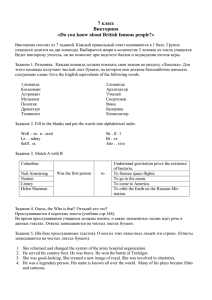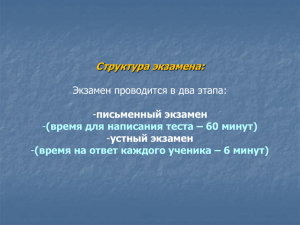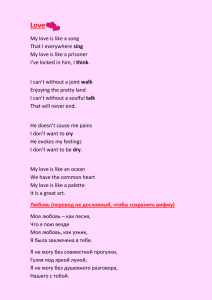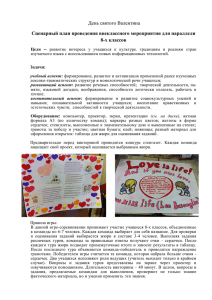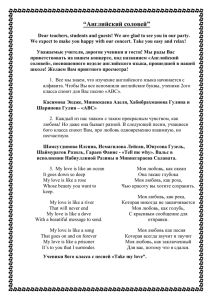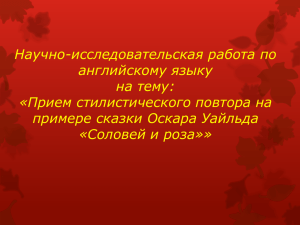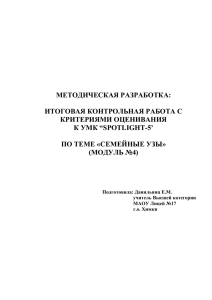Анализ стилистической специфики в сказках Оскара Уайльда (А
реклама
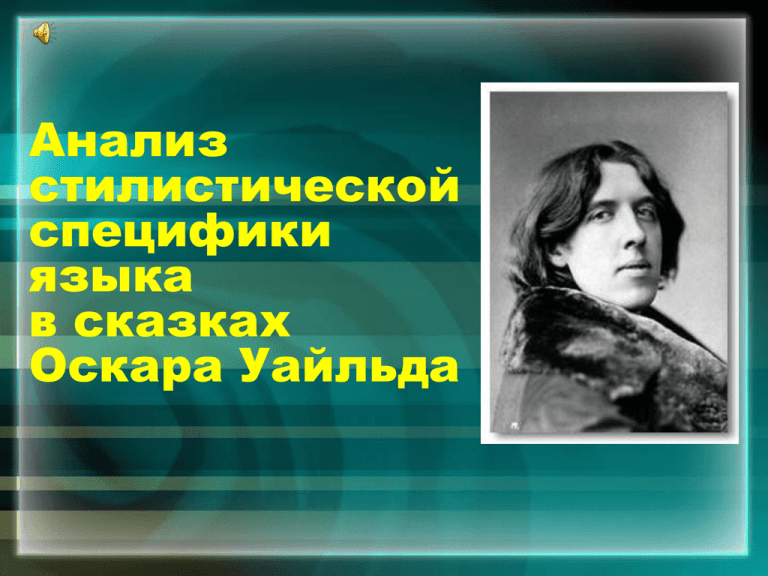
Анализ стилистической специфики языка в сказках Оскара Уайльда Использованные сказки I. II. The Happy Prince The Birthday of the Infanta III. The Selfish Giant IV. The Nightingale and the Rose V. The Remarkable Rocket Все стилистические приёмы, используемые автором, можно разделить на три группы: • Лексические • Графические • Синтаксические Лексические Персонификация Выражает отношение автора к природе The Snow, the Frost, the Hail, the Northern Wind, Winter = he III Summer, Spring, Autumn = she The Nightingale = she IV Love, Sorrow, Life = she IV Sun, Moon = she IV Swallow I Logic IV Green Lizard, Butterfly, Daisy IV Природа глазами Уайльда – это живое существо, принимающее активное участие в событиях сказок The trees forgot to blossom… III The beautiful flowers saw the notice-board and were very sorry for children… III The Frost painted all the trees silver… III Сравнение Выражает видение мира автором • …beautiful flowers like stars… III • …roses are as white as the foam of the sea… IV • …lips are sweet as honey… IV • …he (The Happy Prince) is as beautiful as weathercock… I • …his (Hail’s) breath was like ice III • The streets looked as if they were made of silver. I • …voice, like a water bubbling from a silver jar. IV • …and a delicate flush of pink came into the leaves of the rose, like the flush in the face of a bridegroom when he kisses the lips of the bride. IV Эпитет Вносит поэтичность в произведения False lips V Selfish reason V Cold, crystal moon I Delicate blossom of pink and pearl III The White Moon I Blossoms of Fire V Heavy perfume II Оксюморон Perfect monster V Pretty disdain II Контраст …white rose, red rose; red rose, white rose.. V …anyone can understand that, and I will allow nobody to play in it but myself. III Делает образы живыми, яркими Метафора …the Sun in her chariot of gold, the Moon in her chariot of pearl… I …the pomegranates split and cracked with heat and showed their bleeding red hearts. II …the nightingale sang so sweetly that the Moon leaned to listen. II …the bright pitiless sunshine mocked his sorrow... II …the purple butterflies fluttered… visiting each flower in turn. II …roses that are yellower than the daffodil that blooms in the meadow before the mower comes. II Преувеличение Комичность персонажей o I am so clever that sometimes I don’t understand a single word of what I am saying. V o I will set the whole world on fire and make such a noise that nobody will talk about anything else for a whole year. V Графические Capitalization The Snow, the Frost, the Hail, the Northern Wind, Winter III Summer, Spring, Autumn = she The Nightingale IV Love, Sorrow, Life IV Sun, Moon IV Swallow I Logic IV Green Lizard, Butterfly, Daisy IV Синтаксические Восклицание o o o o o o o o What a wonderful piece of luck! IV How wonderful the stars are! I How happy we are here! III How very ridiculous! IV How I would like to see him! III What a distinguished stranger! I How cool I feel! I What a remarkable phenomenon! I Повтор Усиливает And he (student) went into his room, and печальность, lay down on his little pallet-bed, and безысходность began to think of his love; and, after a time, he fell asleep. IV ситуации Leaf after leaf of the fine gold the Swallow picked off. Leaf after Leaf he brought to the poor. I She (Nightingale) passed through the grove like a shadow and like a shadow she sailed across the garden. (anadiplosis) IV He (Frost) was wrapped in Furs, and he roared all the day about the garden, and blew the chimney-pots down. III Swallow, Swallow, little Swallow… (6 раз в течение всей сказки) I Обратный порядок слов Вносит поэтичность в произведения …and a really fine day it certainly was. II …coloured like flame is his body. IV Later on had followed the marriage, hastily performed. V So great had been his love for her… V …what is joy to me, to him is pain. IV Параллельные конструкции He brushed his hair off his eyes, it imitated him. He struck at it and it returned blow for blow. He drew back and it retreated. V …so I shall sit lonely and she will pass me by. She will have no need of me and my heart will break. IV Кроме того… Парадоксы Выражают отношение автора к разным аспектам жизни • It’s a very dangerous thing to know one’s friends. • Love is not fashionable, the poets have killed it. They wrote so much about it, that nobody believed them. True love suffers and is silent. • I like to do all the talking myself. It saves time and prevents arguments. Выводы Язык Оскара Уайльда чрезвычайно богат стилистически. С помощью таких приёмов как персонификация, сравнение, метафора и т.д. он создаёт яркие живые образы. Ключевое место в сказках Уайльда занимает природа. Персонифицированная, она сочетает в себе стихийные и человеческие качества, помогает раскрыть внутренний мир героя. Яркое воплощение получает образ сада в сказке The Selfish Giant. Изменения сада в соответствии с временами года делят сказку на три периода, отражают состояние героя и создают условия для его нравственного развития. Большинство заглавий сказок представляют собой имя главного героя: Уайльд сосредоточивает внимание читателя на главном персонаже (The Happy Prince, The Infanta) или подчеркивает основную идею произведения (The Selfish Giant). Значительная часть имён – нарицательные, обозначают принадлежность к классу вещей (The Remarkable Rocket), к природе (The Nightingale, Swallow); либо определённую должность (The Happy Prince, The Town Councillor, The Mayor). • Прием контрастa используется для описания противоположных героев (внешность инфанты и карлика), но чаще всего он направлен на выявление основного сюжетного замысла сказки (чередование рассказов ласточки о заморских чудесах с рассказами счастливого принца о жизни бедняков большого города; контраст безграничного высокомерия, надменности и презрения к окружающим “замечательной ракеты”, с полнейшим отсутствием в ней какой-либо действительной ценности ). Однако, несмотря на всю сказочность, нереальность повествования, в произведениях Оскара Уайльда содержится глубокий философский смысл. В первую очередь это доказывает наличие огромного количества парадоксов, выражающих отношение автора к разным аспектам жизни. Многие сказки представляют собой образное, гротескное изображение общества, его несправедливое устройство: те, кто трудятся, терпят лишения и нужду, в то время как другие живут припеваючи за счет их труда. Уайльд обличает алчность и корыстность буржуазии, противопоставляя им искренние чувства простых людей, составляющие подлинную красоту человеческих отношений. Проблемы, описываемые в сказках, актуальны и по сей день, но перестали замечаться в обыденной жизни. Однако восприятие автором этих проблем позволяет нам по-новому взглянуть на них. Работу выполнили: Мусияченко Анна Болдырева Наталья Группа 403а 2008

